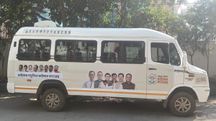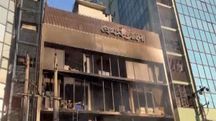NRC in Assam: Truth vs myth
 anomalies
anomaliesBy Anirban Choudhury
Finally, the much-anticipated “complete” draft of National Register of Citizens (NRC) was published in Assam on July 30. And much to the relief of both the Centre and State government, the day passed off peacefully with no untoward incident being reported from any corner of the State despite fears from many quarters indicating otherwise. While of the 3.29 crore applicants, 2.89 crore made it to the complete draft, the remaining 40 lakh didn’t.
The publication of the draft NRC in Assam has managed to draw “national” media’s attention too, but for all the wrong reasons. For, if one is to follow them, the following perceptions emerge: i) lakh of immigrant population will be hounded out of Assam following the NRC update; ii) NRC is being updated purely with this end in mind and iii) the Central and State governments are updating it. And the likes of Mamata Banerjee and Congress president Rahul Gandhi (though it was during Congress regime that the process started) with their utterly ridiculous – if not provocative – comments have only reinforced such a perception among many in rest of the country. The media and political leaders may have their own agenda in hyping fears, but, nothing can be farther from truth.
Agreed, the update may not be foolproof or even desirable in the backdrop of absence of any strategy as to what to do with those unable to prove their citizenship status. But, none can deny that it was one of the most rigorously carried out exercise where applicants were required to prove their residency in the State prior to 1971 or their legacy. So, it’s unfair to attribute any motive, especially because the entire exercise was carried out at the directive and under total supervision of Supreme Court.
Meanwhile, while the implications of non-inclusion of approximately 40 lakh individuals are yet to be fully felt, updating of NRC in Assam could open a virtual floodgate of demands from other States and groups seeking similar registry to insulate them from “outsiders”. And there are already enough indications towards this end with groups in Arunachal Pradesh, Manipur, Meghalaya, Nagaland and Tripura clamouring for similar legal protection. Manipur had already taken a lead with its Legislative Assembly recently passing the controversial the Manipur People’s Bill, 2018 that fixed 1951 as the base year for distinguishing the indigenous from non-indigenous. This led to violence in Jiribam area few days back where a sizeable non-indigenous population reside and who are opposing it on the ground that when Manipur achieved Statehood in 1972, how 1951 can be considered a base year.
For the uninitiated, Assam is the only State in the country to have an NRC that was prepared based on the census of 1951 and had names of the entire residents of the State then. As the issue of immigration was intrinsically linked with Assam’s history since early 20th century, especially in the backdrop of the country’s partition 1947, due to which the State witnessed a sharp rise in influx from then East Pakistan, it was considered prudent to prepare the NRC then.
The entire issue of updating NRC first cropped up when the All Assam Students’ Union (AASU), as part of its bid to weed out “illegal” immigrants from the State, submitted a memorandum in this regard to the Centre on 18th January 1980 during the six-year Anti Foreigners’ Movement in the State from 1979 to 1985. The AASU continued raking up the issue persistently thereafter, before the then NDA government at the Centre agreed in principle to update the NRC during a tripartite meeting in New Delhi involving representatives of the Centre, State government and AASU on 17th November 1999.
Only one-of-its-kind exercise in any part of the globe to determine citizenship, however, the decision to update the NRC was taken during another tripartite meeting involving officials of Ministry of Home Affairs (MHA), State government and AASU representatives in New Delhi on 5th May 2005. Then Chief Minister Tarun Gogoi was also present at the meeting, which was presided over by then Prime Minister Dr Manmohan Singh, who committed himself to update the NRC by September 2007.
The tripartite meeting followed a dramatic turn of events in the previous year. The AASU had declared a boycott of Singh when the latter’s visit to Guwahati was scheduled in November-end 2004 to flag off the first Indo-ASEAN car rally. Accusing the Centre of neglecting implementation of the Assam Accord and holding Singh responsible for it, the influential students’ body had declared that it would to prevent his visit at any cost.
Faced with an embarrassing situation of the Prime Minister’s visit to Guwahati being jeopardised in front of Heads of States of ASEAN countries and national and international media, Gogoi called an emergency meeting with AASU representatives and assured them that he would fix a meeting for them with Singh. Following this, the AASU had withdrawn its boycott call. Thereafter, the tripartite meeting was held in New Delhi on 5th May 2005 wherein the decision was taken to update the NRC on the basis of NRC of 1951 and electoral rolls up to 1971.
However, neither the Centre nor the State government, both of which were ruled by the Congress then, took any initiative on the matter. After sitting on it for five years, both New Delhi and Dispur then decided to take up the exercise in Chaygaon and Barpeta revenue circles in 2010 as a pilot project. But, after widespread violence in Barpeta in which four persons lost their lives in July that year, the Tarun Gogoi Government immediately called off the project.
The NRC update exercise was then put on cold storage till the Supreme Court took up hearing on a public interest litigation filed by Assam Public Works (APW), an NGO, on July 20, 2009. The APW had sought directives from the apex court to the Central and State governments to correct Assam’s electoral rolls as the organisation alleged that names of 41 lakh illegal immigrants had been included in them. It was then that both the Centre and State government told the Supreme Court that since the NRC was being updated, the matter would be automatically taken care of as those names not included in the NRC would not be included in the electoral rolls too.
And that was how the NRC update came under the apex court’s monitoring. Subsequently, the AASU was made a party to the case. The Supreme Court, after hearing all parties to the case, then issued a directive in 2013 that the NRC be updated. And accordingly, the process was initiated in 2014 and enrolment started in 2015. The court had set post midnight of 31st December 2017 as deadline for publication of the first NRC draft after constant follow-ups with the authorities concerned – Registrar General of India (RGI) and Office of the State Coordinator of NRC, Assam. Earlier, the NRC update had missed the deadline of 31st December 2015. Though both the RGI and NRC State Coordinator had sought extension of the deadline on more than one occasion, the apex court had stuck to its gun with the deadline of post midnight 31st December 2017 for publication of the first part draft of NRC.
And the rest is history. At the stroke of 12 on New Year’s Day, fate of 1.90 crore individuals were decided in the first part NRC draft, while the fate of remaining 1.39 crore that hanged in balance was decided with publication of “complete draft” on July 30. Authorities concerned once again reiterated that “genuine” Indians shouldn’t be perturbed as their names won’t be left out and given another chance to include their names, while all foreigners would be excluded. The reason for somewhat tardy progress thus far was largely attributed to non-completion of verification of documents, which too was a colossal 6.50 crore, to validate proof of residency and legacy of the 3.29 crore applicants.
So, against such a gargantuan exercise monitored closely by the highest court of the land and where each and every document is painstakingly cross-checked – queries sent to issuer of documents to other States and abroad (37 countries) for cross-checking – it is ridiculous to attribute a motive. And not just Bengali Hindus or Muslims, many “indigenous” people’s names too have been left out in the NRC draft
Copyright©2025 Living Media India Limited. For reprint rights: Syndications Today








